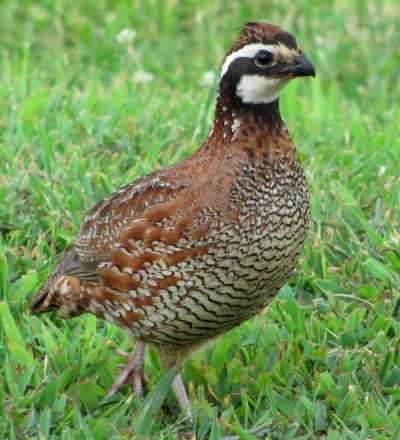 SKC Films Library |
| SKC Films Library >> Science >> Zoology >> Birds >> Order Galliformes |
| Bobwhite Colinus virginianus [kol' I nuhs ver jin' E an nuhs]
Description The bobwhite is a relatively small game bird, weighing approximately 5-6 ounces, and averaging 8-10 inches in length, with a 3.5-4.7- inch wingspan. It has rounded wings and square tail. Adult males are distinguished from females by their white facial stripes and throat and sharply contrasting black markings on the feathers. There are over a dozen subspecies, differentiated by region, with some differences in overall coloration between them. Distribution and Habitat The bobwhite ranges from southeastern Ontario into Central America, with the highest population densities being found in the eastern United States and Mexico. There are also populations in Cuba, and disparate populations in Washington, Oregon, Idaho, and northwestern Mexcio. In forest habitats bobwhites have a preference for early successional vegetation zones created by fire, agriculture and/or timber-harvesting. In rangeland habitats they live in both early and later successional vegetation. In either case the habitat must contain a diversity of invertebrates, seeds and herbaceous plants, and must have an abundance of cover for protection from predators and weather. Reproduction Once thought to be strictly monogamous, it is now known that both male and female bobwhites are capable of incubating and raising broods with more than one mate during any given breeding season. Breeding season runs from February into October, depending on region. Although bobwhites normally only breed once a year, up to three broods may be raised in any one season. The nest, which is built by both sexes, consists of a saucer-shaped, softball-sized depression in the ground lined with dead grasses. Six or more pure white eggs are laid per clutch, and are incubated by both parents for about 23 days. Hatchlings are able to walk about and follow their parents almost immediately, and fledge at about 14 days. If the nest is threatened, one parent typically stays with the hatchlings while the other engages in distractive displays in hopes of luring the threat away from the nest. Nests that are destroyed before hatching are usually rebuilt, but broods lost after hatching are usually not replaced. Although bobwhites can live up to 6 years in the wild, fewer than 15% of any given population typically live past their first year. Social Behavior Beginning in the late summer, bobwhites form into coveys of parents, offspring and unsuccessful breeding pairs. The coveys become fluid by autumn, and family groups have dispersed by late autumn or early winter. Bobwhites produce a variety of calls to direct covey movements and warn of danger, including the familiar "bob-white" call which gives the bird its name. Bobwhites are most active during the early morning and late afternoon hours. They spend most of their time on the ground, but can fly short distances if necessary. Individual populations typically spend their entire lives in one place. Diet Bobwhites feed primarily on seeds, supplemented by green leafy material, fruits, and invertebrates. Scientific Classification phylum Chordata
SOURCE |
| SKC Films Library
>> Science
>> Zoology >> Birds >> Order Galliformes This page was last updated on March 22, 2018. |
